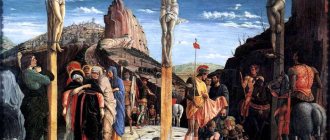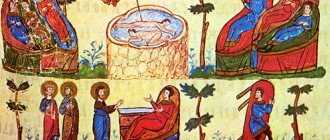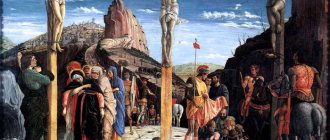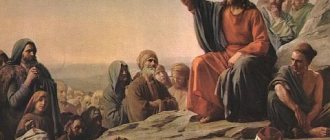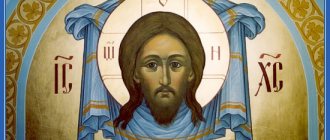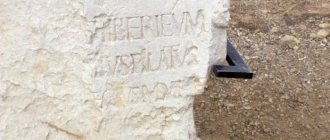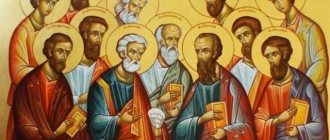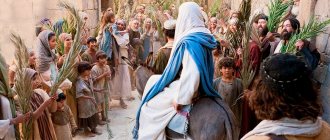Author: Irina Vysokovskaya
Date of publication: 04/24/2016
Christians, gradually purified and prepared by the Holy Church during the days of the Holy Pentecost, enter after the Week of Vay into the last week of Great Lent, preceding Easter. This week is called Passionate, or Great. It is called Passionate because it is dedicated to the remembrance of the last days of our Savior’s earthly life, His suffering (“passion”), death and burial. According to the explanation of St. John Chrysostom, it is called Great because in these days great deeds were accomplished by the Lord: the long-term violence of the devil was destroyed, death was defeated, sin was defeated, the curse was lifted. The Lord opened paradise, and heaven became accessible to man from now on; people united with the Angels, the mediastinum (barrier) of sin was destroyed and removed, and the God of peace reconciled the heavenly and earthly through the recreation, renewal and deification of human nature. All the services of this week, distinguished by their length and special touching, are arranged in such a way that they gradually recreate the entire history of the Savior’s suffering, His last, dying words and Divine instructions. Each day of the week is given a special remembrance, expressed in chants and Gospel readings.
PASSIONATE WEEK. GOSPEL STORY. Saint Theophan the Recluse
ENTRANCE TO JERUSALEM
The very last days of the Lord began with the day of His triumphal entry into Jerusalem. Here the legends go day after day and definitely establish the course of events in them. All that remains is to list them.
The movement towards the city began early that day. Approaching the Mount of Olives, the Lord sent to a village visible ahead, standing at the foot of the Olivet, to bring from there, at His direction, a donkey with a foal, and when they brought it, he sat on the foal and continued the procession. The people accompanying Him became incredibly excited: they spread clothes and tree branches on the path of the Lord and cried out: Blessed is He who comes! Those gathered for the holiday in Jerusalem heard about the movement of the Lord, went out to meet Him and, in turn, spread clothes and tree branches along the way. Everyone cried: Hosanna! Blessed is the one who comes! And the Lord shed tears about the fate of the city and the people. Having entered the city, shocked by this extraordinary event, the Lord went to the temple, cleansed it of traffickers, performed many healings, received praise from children and, when the Greeks asked to see Him, with the appeal: now the Son of Man has been glorified, he has attracted testimony of Himself from above and to everyone spoke a word about the power of His incarnate economy. The Lord returned to Bethany at night.
GOOD MONDAY
The next day, after the solemn entry into Jerusalem - on Holy Monday - the Lord again went to the temple; on the way he uttered a symbolic curse on the fig tree, and to the disciples - a word about the power of faith when they expressed their amazement at the effect of the curse; in the temple - again cleared it of traffickers . Probably these traders, after their expulsion yesterday, again settled in their places, because the church authorities did not forbid them to do so; The Lord Jesus was a third party for them. He acted on the conscience, which they were already accustomed to calming about their own, irreverence towards the house of God, denouncing, acting.
In the evening the Lord again departed to Bethany. Of course, a lot has been said and done to this day. But it was not pleasing to the Lord that this should be communicated to us.
GOOD TUESDAY
On the third day - on Holy Tuesday - during the procession from Bethany to Jerusalem, the disciples, seeing the withered fig tree, again expressed their amazement and again heard the word of the Lord about the power of faith. And on the last day, amazement was expressed by the disciples, and the word of the Lord about the power of faith was spoken. Nowadays both are repeated. The astonishment of the disciples was now excited by the degree of dryness - to the root. And yesterday there were obvious signs of drying out, but that was the beginning, but now it is all dried up to the roots. And the Lord’s word about the power of faith more clearly indicates the properties of such faith.
Then, throughout this day, the Lord held many conversations in the temple with the church authorities, scribes, Pharisees and Sadducees, and outside on the Mount of Olives with the disciples.
In the temple, the Lord first gave an answer to those who asked Him by what authority He acts .
Then He began to admonish the church authorities with parables; and spoke a parable : about two sons , of whom, at his father’s invitation to go work in the vineyard, one answered: I don’t want to, and then he went; and the other: I am going, and did not go; about the winegrowers who first beat the servants of the owner of the grapes, and then killed his son; about those invited by the king to supper , on the occasion of the marriage of the king’s son, and those who refused due to everyday matters.
Then he resolved some of the confusion of those who asked: whether or not to give tribute to Caesar ; how to reconcile the law of life with the doctrine of the resurrection of the dead; and what is the first commandment?
After this, silencing the co-questioners with the question: how is Christ the son of David, when David calls Him Lord? - He uttered many accusatory reproaches to the scribes and Pharisees.
And finally, valuing the widow’s insignificant contribution , He withdrew from the temple and the city.
Passing by the temple, He uttered a prophecy about its fate; Having ascended the Mount of Olives, he predicted the fate of the city and the people, and finally, the fate of the whole world .
called upon His disciples, and in their person and all of us, with several tributary sayings, to take care, watch and pray in anticipation of His second coming , the Lord concluded His conversation with the image of the Last Judgment .
Having finished His conversation with the disciples, the Lord said that Easter would be in two days. The fourth and fifth days lay ahead, after the Lord’s triumphal entry into Jerusalem—Wednesday and Thursday were clean. The Lord may have retired to Bethany for the night, or spent it right there on the mountain, in a famous garden.
GREAT WEDNESDAY
On Wednesday there was a meeting of the Sanhedrin about the destruction of the Lord , probably in the morning; in the evening, in the house of Simon, a supper was held for the Lord .”...And when He was in Bethany, in the house of Simon the leper, and reclined; a woman approached Him with an alabaster vessel of precious ointment; and, breaking the vessel, she poured this ointment on His head as he reclined. Seeing this, His disciples and some others were indignant and said to each other: “Why such a waste of the world? For this ointment could have been sold for a great price, more than three hundred denarii, and given to the poor.” And they grumbled at her. But the Lord Jesus, realizing this, said to them: “Why are you embarrassing the woman? Leave her alone. She did a good deed for Me. For you always have the poor with you and, whenever you want, you can do good to them, but you do not always have Me. She did what she could. Having poured this ointment on My body, she prepared Me for burial. Truly I say to you: wherever this gospel is preached throughout the whole world, what she has done will also be spoken of in her memory...”
And at night, as is more likely, Judas sold the Lord for thirty pieces of silver .
Where did Christ go to Calvary?
Photo by Vladimir Eshtokin
The greatest questions from an archaeological point of view are raised by the so-called Sorrowful Way of the Lord, or Via Dolorosa, along which numerous Christian pilgrims walk from Gethsemane to the Church of the Holy Sepulchre.
We must understand that Via Dolorosa is the route of the religious procession of Catholic pilgrims. It was finally established after the Crusades in the 14th century. The Franciscans decided that the likely location of Pontius Pilate's praetorium was the Fortress Antonia. The procession route, which previously passed south of the Temple platform, was moved closer to the fortress. But the Byzantine pilgrims walked differently, and this path was much closer to what can be established on the basis of archaeological data.
Father Alexander Timofeev, author of the text, at the excavations
Memorials of this kind in Jerusalem, like Via Dolorosa, should be treated as some kind of icon in the area. And an icon, as is known, although, unlike a portrait, does not convey the image with thorough accuracy, it nevertheless opens the way to a meeting with the event or the person depicted.
GREAT FOUR
Maundy Thursday is marked by the Last Supper . The course of events of the day was as follows: during the day everything needed for the evening was prepared; when the time came, everyone came to the upper room and sat down; Before eating the Easter supper, the Lord stood up and washed the disciples' feet ; at the end of the word to Peter on this occasion, the Lord mentioned that they - the disciples - were pure, but not all, hinting at a traitor, and then, when the eating of the supper began, He rebuked Judas three times to admonish him and finally with the word: what have you decided to do? do it quickly,” he forced him to leave; at the end of the Easter Supper, the Lord deigned to establish a new sacrament of the Body and Blood - the sacrament of the sacraments, the New Testament Passover .
Having resolved after this a dispute that accidentally arose between the disciples about which of them was the greatest, the Lord began a farewell conversation , in which the voices of some of the disciples were first heard, and then the Lord alone spoke, saying everything that they could contain and that could serve as consolation and guidance. them in the sorrowful circumstances that lay before them. The farewell conversation, presumably, was delivered entirely in the Easter room. Although at the end of the 14th chapter of the Evangelist John it says: ... get up, let us go from here; but the great importance of what was offered to those spoken after that, especially the concluding prayer to God the Father, forces us to admit that even after those words the Lord still remained in the upper room and continued speaking, perhaps while standing. On the way, it was inconvenient for everyone to hear everything that was said, but it was absolutely necessary for everyone to hear it. And it was especially inconvenient to say a prayer to God the Father on the way.
Finally, having said a few words at the end of the entire supper, the Lord made the transition to the Garden of Gethsemane.
Where did the Last Supper take place?
Nowadays in Jerusalem they show the approximate location of the Last Supper, which is called the Upper Room of Zion. It represents the remains of a church built around the 14th century by the Franciscans and later converted into a mosque by the Arabs. Therefore, we must understand that the current Upper Room of Zion is not the same room in which the Last Supper took place. Moreover, we can only establish approximately the location of the house described in the Gospels.
Zion Upper Room
Currently, under the Zion Upper Room there is a synagogue in which the tomb of King David is shown. If this is really the same tomb, then the words of the Apostle Peter, spoken on the day of Pentecost, become clear: Men, brethren! let it be allowed to boldly tell you about the forefather David, that he died and was buried, and his tomb is with us to this day (Acts 2:29).
On this day, the apostles gathered in the same place where the Last Supper took place, and according to legend, the house of the Apostle Mark appeared to them. The Apostle Peter seems to be pointing to the tomb. In this case, the Zion Upper Room may indeed be connected with the tomb of King David, since according to legend, the family of the Apostle John Mark was the custodian of the tomb of King David.
THE SUFFERING OF THE LORD
From that moment the suffering of the Lord began. The foundation was laid on this night, from Thursday to Friday.
Everything here: the prayer for the cup, the taking of the Lord, His transfer to the house of the high priests and His presence in this house at night - follows the instructions of the legends themselves.
To eliminate confusion when reading the legends about this last thing, we must remember that the houses, or dwellings, of the high priests Annas and Caiaphas were in the same courtyard. This eliminates the questions of why the Lord was brought to Anna and into which house John and Peter were brought. After bringing the Lord to the high priestly court, it was necessary to wait a little while the members of the Sanhedrin gathered. As Anna wanted to see the Lord, he ordered Him to be brought to her, instead of standing for Him in the courtyard. Then the transition from Anna to Caiaphas was a transition from one wing to another. What happened to Caiaphas ended with the condemnation of the Lord and the mocking of Him; after which He was taken out into the courtyard and guarded until the morning, continuing the abuse.
While the Lord was being tried and condemned, in the same courtyard the threefold denial of Saint Peter took place, according to the word of the Lord. This happened during those minutes that the Lord spent with Anna. When the Lord was transferred from Anna's building to Caiaphas, or to where the Sanhedrin had gathered, Saint Peter thought to take advantage of the movement that was happening and leave the court, but one maid took over from him, pestered him with a question and forced him to renounce. Saint Peter, however, did not give up on his intention and headed towards the gate that led from the inner courtyard to the front. Then another maid met him with the same question, and he denied it before her. As soon as he went out into the front yard, those who were there pestered him with the same question; the need had to be renounced before them too. Immediately the petel cried out, - and the Lord, having already been taken out of the Sanhedrin and standing in the courtyard, looked at Peter. - And going out, Saint Peter wept bitterly.
After this, everything in the yard became quiet until the morning. Only the guards from time to time did not stop mocking the Lord.
Where did Pilate judge Christ?
Another question that remains open for archaeologists is the location of Pilate’s trial of Christ. Probably, this event did not take place in the Antonia fortress, but in the former palace of Herod the Great, which was at the disposal of Pontius Pilate.
Reconstruction of Herod's palace, model
It is interesting that Josephus describes the actions of the procurator of Judea, Gessius Florus, precisely in the palace: “Florus spent the night in the royal palace, and the next day he ordered a judge’s chair to be placed in front of the palace, which he ascended. The chief priests and other high-ranking officials, as well as all the nobles of the city, appeared before this judgment seat” (Jewish War. II, 14:8).
GREAT HEEL
On Friday morning, the church authorities met again and again questioned the Lord, hoping to discover something more, but they received only confirmation of what they had previously inquired about. And this was very enough for their conscience.
Then the Lord was handed over to Pilate, the hegemon, in order to receive from him the condemnation of the Lord to death. Here they have a different speech, everything is in a political tone. Pilate immediately saw that the accused was not mortally guilty. But, not wanting to condemn the Lord and do something unpleasant to the Jews, as soon as he saw the case, he hastens to reject the judgment and conveys the Lord to Herod. However, this one did not find mortal guilt on the one brought to him and let Pilate know about this, dressing Him in white clothes.
Pilate again had to decide the matter himself. He did not want to condemn the Lord, recognizing His innocence of death. But he was weak in his love for the truth and, instead of relying on the power of this truth, he turned to third-party aids that did not produce the expected effect on those accusing. The comparison of the Benefactor with the villain served no purpose in order to induce them to choose to absolve the former; The testimony of the wounded and bloodied man did not produce any effect in order to arouse pity and induce them to be satisfied with this execution.
Bear the friend of Caesar - finally took away from Pilate all energy to defend the Righteous One - and he condemned Him to crucifixion. The people take the blood of the Lord upon themselves; Pilate washes his hands; everything is settled in this way. - And the Lord is led to death with two villains.
On the way, blessed Simon of Cyrene is honored to bear His cross for the Lord; Crying wives receive a lesson to cry about themselves, instilling fear for everyone.
On Calvary they crucify the Lord, divide His vestments and mock the Crucified One. For this, seven words of the Lord are heard from the Cross, which began with a prayer for crucifiers and blasphemers, and ended with the surrender of His spirit into the hands of the Heavenly Father.
From the sixth hour to the ninth there was darkness; at nine o'clock the Lord gave up the ghost with the amazing signs that accompanied it, which forced the people, beating the Persians, to return to themselves.
Then everything became quiet. Only the anger of the enemies did not find peace. They asked permission to break the legs of the crucified people, so that, having brought them to death, they could remove their bodies. But in relation to the Lord it was not according to their desire. In fulfillment of the prophecies, His legs were not broken—he was alive, but the rib of someone who had already died was perforated; and His body was removed not as the body of evildoers, but as the body of a person reverently honored and worshiped by Joseph and Nicodemus, no doubt, not without the participation of other persons close to Him.—- The wives watched as they laid the Lord in the tomb.
We place the repentance of Judas with his despair and destruction at the end of the events of Friday, so as not to stop the legends about what happened to the Lord. Moreover, in his despair, he turned to the high priests, who until the evening were busy with the unrighteous condemnation of the Lord and had no time for Judas. All events of Good Friday are determined during their course by the instructions of the legends about them.
Der Spiegel (Germany): the last days of Jesus of Nazareth
For a long time it was fundamentally unclear whether such a place as Magdala existed. In the 70s of the 20th century, monks found its ruins, but the final discovery was made by experts from the Israeli Archaeological Service only in 2009. That year, a certain church minister decided to build a shelter for pilgrims near Lake Tiberias, raised money and bought a dilapidated hotel called Hawaii Beach. Before the excavator began demolishing the building, officials were obliged to check the foundation - and at a depth of half a meter they came across the ruins of a once rich settlement. This was Magdala, Mary's homeland.
And a couple of years later, archaeologists found something else there: a synagogue. In the past, many skeptics claimed that Jesus could not have preached in the synagogues of Galilee because there were simply no synagogues in the countryside at that time. But in Magdala, on the shores of Lake Tiberias, evidence to the contrary was discovered.
When Jesus arrived in Jerusalem, two powerful men were there preparing for the festival: Pilate and Caiaphas. Along with Jesus, they became the main characters in the history of the emergence of Christianity. Pontius Pilate, the Roman prefect of Judea, is mentioned numerous times in historical documents. What about Caiaphas, the high priest of Judea? He has long been considered the main villain of the drama of Jesus' last days.
Rebel
While the city filled with pilgrims ahead of the approaching Passover holiday, Jesus did what he did best: preaching, rebuking the authorities, and healing, mainly around the public baths. Of course, he did not possess miraculous powers, but he may have used suggestion. This still happens today - at least for a while - with miracle healers who use their charisma.
One of the places where Jesus allegedly performed healings was Bethesda, the pool north of the Temple. Its ruins were discovered by archaeologists back in the 19th century. The second body of water, the Pool of Siloam, was discovered only a few years ago by city builders who were laying a sewer pipe.
The Pool of Siloam, which has not yet been fully excavated, is much larger than a regular pool: 70 meters long and 40 to 60 meters wide. Despite this, she disappeared from the face of the earth for centuries. The size gives an idea of the kind of crowds that gathered there before Passover. An ideal place for a preacher. And a rebel.
David Mevorach of the Jerusalem Israel Museum says: “When believers flocked to Jerusalem for one of the main holidays, many of them found a place to stay outside the city in camps prepared for this purpose.” Archaeologists have discovered the remains of three such pilgrimage camps.
Temple
From the Pool of Siloam up to the Great Temple, the main shrine of the Jews, one could climb along two cobbled streets. Today this path passes through one of the Arab quarters. Ancient streets lie under the foundations of houses and under a layer of earth up to ten meters thick. Israeli archaeologists dug tunnels there and cleared some of them so that they can now be walked on. The Palestinian residents were not asked for permission to do this.
Some excavation work is carried out in the presence of guards with machine guns, but in Israel they do not like to talk about this in public. As one person familiar with the work put it, it is "an extremely important, but unusual and purely political excavation."
The luxury of the Temple should have affected people at first sight as a revelation. The supporting walls are more than 30 meters high and are made of huge limestone blocks. Golden facades reflect the sun. Sheer magnificence.
According to Mevorach, the Temple was "the largest sacred structure ever erected in the Roman world." The area of its base was larger than the Roman Basilica of St. Peter, together with the area in front of the entrance.
The priests constituted the Jewish elite, their families were rich and influential. However, only Roman prefects had the right to appoint and remove high priests.
Pontius Pilate and the high priest Caiaphas apparently had a relationship of trust. Under the Roman occupation, the high priests did not lose their privileges and lived in luxury. The magnificent palace, discovered during excavations at the southwestern foot of the Temple Mount, is considered by some to be the home of Caiaphas. But for a long time this man remained a phantom, only a literary hero.
Several years ago, archaeologists discovered an oblong limestone box in the south of Jerusalem - the so-called ossuary. The bones of the dead were kept in ossuaries; a number of such stone containers from that era were found.
“But,” says Mevorach and points to the elegantly executed floral designs, “this is one of the most beautiful ossuaries we have seen.” And most importantly, on both sides of the box the name is written in Aramaic: “Caiaphas.”
The Temple cult in Jerusalem was most likely a great business for Caiaphas and his elite priests. Having ascended to the Temple, the provincial Jesus probably ended up in the so-called Pagan court. Merchants offered sacrificial animals, approved by the priests and therefore worth more than below in the city. The money changers offered special coins that were used to pay the temple tax, and received an eight percent commission for this.
As the Bible says, Jesus was furious at this type of fraud. Mark (actually Matthew - approx. transl.) says: “And ... he overturned the tables of the money changers and the benches of those selling doves, and said to them: it is written, “My house will be called a house of prayer; but you made it a den of thieves” (Matthew 21:12-13).
If he really said so, then he thereby turned the priests against him.
Process
Many descriptions from the Bible coincide with archaeological data. But precisely for the episodes described by the evangelists with special religious passion, there is neither historical nor archaeological evidence. One example is the Last Supper.
That very solemn meal during which Jesus said that the bread and wine were his flesh and blood. We have to take it on faith. The house where Jesus allegedly had his last meal with his disciples was built during the time of the Crusader knights on top of an ancient place of worship. There is no evidence that the episode described in the Bible actually happened.
It's the same with the story of Judas. There is no historical evidence anywhere about this man, the place associated with him, or the 30 pieces of silver.
But Tacitus and Josephus clearly confirm that Jesus, after speaking at the font and in the Temple, was detained and brought to Pontius Pilate. Both historians have evidence of the latter’s sentence.
The Gospels say that Jesus was first questioned by Caiaphas and other leading priests. After this, the Jewish rulers handed him over to the Roman government authorities. This corresponded to the then division of competencies.
The trial was quick, but it was held according to the rules, and the final decision had to be made by the highest authority - the prefect. The high priest could present Jesus in the worst possible light, demand a sentence for him, but he himself could pronounce a death sentence only if it was a question of desecration of his Temple. But this was not the case. Therefore, Caiaphas had to involve Pilate in the case.

